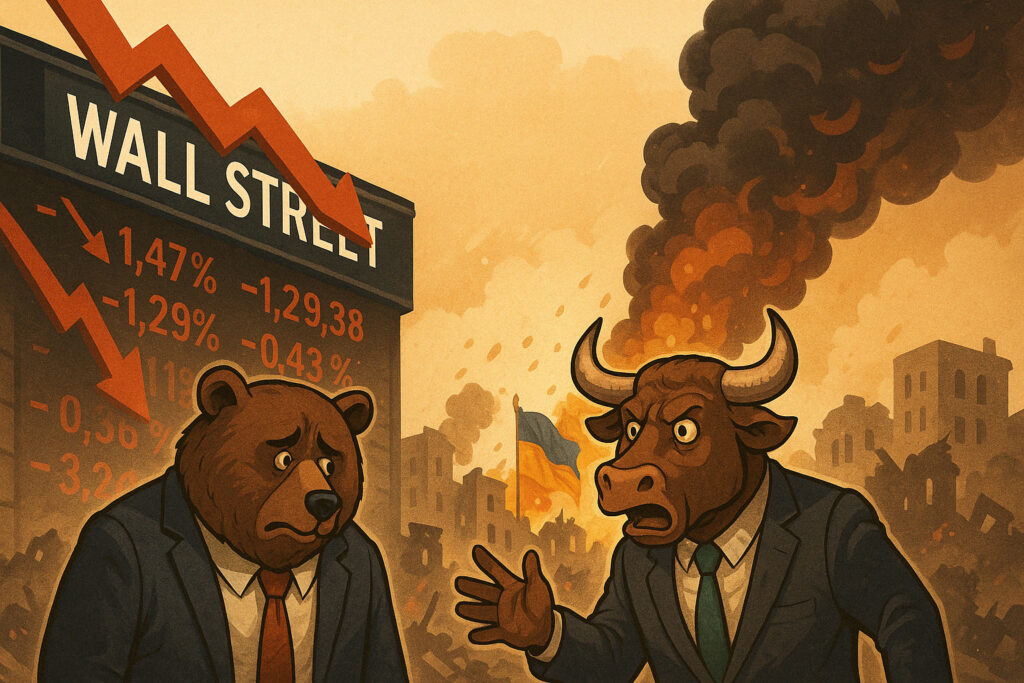Date: March 17, 2025
Wall Street closed slightly lower on Monday as a renewed escalation in the Ukraine conflict sent ripples through global markets, rekindling fears of prolonged geopolitical instability in Eastern Europe. The recent flare-up in military activity, following Russia’s overnight missile strikes near Odesa and renewed troop buildups near Kharkiv, has once again placed Ukraine at the forefront of investor concerns. As a result, risk sentiment retreated across equities and commodities alike, leading to a cautious pullback in major indices and a flight to safe-haven assets.
Geopolitical Escalation: What Happened?
Late Sunday, Ukrainian officials reported a barrage of missile and drone attacks targeting energy infrastructure and military logistics in the country’s southern and eastern regions. This new wave of aggression, the most significant in over four months, marks a sharp deterioration in the regional security environment. Intelligence sources from NATO confirmed an uptick in Russian military mobilization along the northeastern border, prompting emergency meetings among EU foreign ministers.
Global condemnation followed swiftly. The U.S. State Department labeled the actions “escalatory and destabilizing,” while European Union leaders called for additional sanctions to be discussed in Brussels this week. The re-intensification of hostilities has reignited concerns around energy security, food supply chains, and broader market stability—especially as the conflict threatens to spill over into neighboring territories.
Market Reaction: Equities Retreat Cautiously
On Wall Street, traders responded with apprehension. The S&P 500 slipped 0.34% to close at 5,082, while the Dow Jones Industrial Average fell 112 points (-0.28%) to 38,119. The tech-heavy Nasdaq Composite dipped 0.42% to 15,775, snapping a three-day win streak.
Sector Breakdown:
- Defense stocks were among the few winners, with Lockheed Martin (LMT) climbing 3.1% and Northrop Grumman (NOC) rising 2.6%.
- Energy shares saw modest gains on rising crude prices, with ExxonMobil (XOM) up 1.2%.
- Tech and growth sectors, particularly semiconductors and cloud, led the declines, driven by de-risking and rising bond yields.
VIX, the so-called “fear index,” jumped 8.7% to 17.9, signaling heightened market anxiety.
Global Markets Echo the Tension
European stocks also declined amid the geopolitical uncertainty:
- The Euro Stoxx 50 fell 0.6%, with German and French benchmarks seeing their worst single-day drop in nearly a month.
- The FTSE 100 edged lower by 0.3%, held up partially by defense and commodity shares.
Meanwhile, Asia closed mixed earlier in the day, with Tokyo’s Nikkei 225 down 0.2% while Hong Kong’s Hang Seng gained 0.4%, largely due to positive local property earnings.
Commodities React: Oil and Gold Surge
The geopolitical upheaval fueled a jump in energy and precious metal prices:
- Brent crude surged 2.7% to $89.45/barrel, as traders feared supply disruptions from Russia and Ukraine’s export terminals.
- West Texas Intermediate (WTI) rose 2.5% to $85.32/barrel.
- Gold, the quintessential safe haven, rallied 1.9% to $2,228/oz, approaching its all-time highs reached earlier this month.
- Silver also gained, up 2.3% to $26.92/oz.
Natural gas prices in Europe spiked 6.4% on concerns about pipeline infrastructure risk, reviving winter supply fears.
Safe-Haven Flows: Bond Yields Dip
As risk-off sentiment took hold, U.S. Treasury yields declined:
- The 10-year yield fell 7 basis points to 3.91%.
- The 2-year yield dropped to 4.26%, down from 4.35% on Friday.
Bond traders appear to be partially pricing in renewed geopolitical risk premiums, even as Federal Reserve policy remains in focus later this week.
Crypto Treads Water
In contrast to other risk assets, cryptocurrencies were relatively stable:
- Bitcoin (BTC) traded flat at $67,850, consolidating gains after last week’s ETF-driven surge.
- Ethereum (ETH) held near $3,950, slightly off its $4,000 peak.
- Solana (SOL) and Avalanche (AVAX) saw mild pullbacks, each down roughly 1.5%.
Market analysts noted that crypto traders appear to be taking a wait-and-see approach, with low leverage and limited positioning ahead of the Fed’s decision on Wednesday.
What’s Next? Forward-Looking Implications
1. Energy and Commodities in Focus
With energy infrastructure now a potential target, traders will keep a close eye on oil and gas flows through Ukraine and the Black Sea. European energy dependency is still a key macro risk. Any escalation impacting these corridors could lead to a renewed energy crisis reminiscent of 2022.
2. Policy Responses
Expect emergency meetings from NATO, EU, and possibly a special session at the UN. Any new sanctions could affect European exporters and financial institutions with exposure to Russian markets.
3. Investor Caution Ahead of Fed Meeting
While geopolitical headlines dominate today, investors are simultaneously bracing for the upcoming FOMC decision on March 20. Expectations remain for a rate hold, but any dovish pivot could reinforce the case for longer-term equity resilience. Still, in the short term, war-driven volatility is likely to dictate market tone.
Expert Commentary
“Geopolitical risk premium is back,” says Jane Rottweiler, Chief Investment Strategist at Eclipse Asset Management. “Markets had largely priced out tail risks in Ukraine, but this weekend’s escalation is a reminder that dormant conflicts can quickly reshape macro narratives.”
“We’re seeing classic risk-off moves today: Treasuries bid, equities down, gold up. But the Fed’s stance later this week will ultimately determine how deep this correction goes,” added David Lu, Global Macro Analyst at Hightower Capital.
Investor Takeaways
- Rebalance exposure: Investors should reassess sector allocation, potentially increasing exposure to energy, defense, and gold-linked assets.
- Volatility hedging: The uptick in VIX suggests an opportunity to protect downside via options or inverse ETFs.
- Watch Eastern Europe: Developments in Ukraine could now set the tone not just for European markets but for global macro sentiment.
Conclusion
The sharp reminder of geopolitical fragility in Eastern Europe has reignited market volatility and upended investor complacency. While the pullback in Wall Street was modest, the broader message is clear: risks once considered dormant can return with destabilizing force. As markets digest these events and look to central bank guidance later this week, caution remains the order of the day.
Investors must now navigate a complex environment of geopolitics, policy, and positioning, with one eye on Ukraine and the other on Washington.
